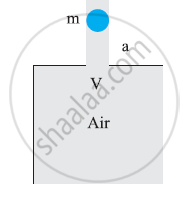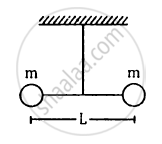Advertisements
Advertisements
प्रश्न
One end of a U-tube containing mercury is connected to a suction pump and the other end to the atmosphere. A small pressure difference is maintained between the two columns. Show that, when the suction pump is removed, the column of mercury in the U-tube executes simple harmonic motion.
उत्तर १
Area of cross-section of the U-tube = A
Density of the mercury column = ρ
Acceleration due to gravity = g
Restoring force, F = Weight of the mercury column of a certain height
F = –(Volume × Density × g)
F = –(A × 2h × ρ ×g) = –2Aρgh = –k × Displacement in one of the arms (h)
Where,
2h is the height of the mercury column in the two arms
k is a constant, given by `k = - F/h = 2Arhog`
Time period, `T = 2pisqrt(m/k) = 2pisqrt(m/(2Arhog))`
Where,
m is the mass of the mercury column
Let l be the length of the total mercury in the U-tube.
Mass of mercury, m = Volume of mercury × Density of mercury
= Alρ
`:. T = 2pisqrt((Alrho)/(2Arhog)) = 2pi sqrt(l/2g)`
Hence, the mercury column executes simple harmonic motion with time period `2pi sqrt(1/(2g))`
उत्तर २
The suction pump creates the pressure difference, thus mercury rises in one limb of the U-tube. When it is removed, a net force acts on the liquid column due to the difference in levels of mercury in the two limbs and hence the liquid column executes S.H.M. which can be expressed as:
Consider the mercury contained in a vertical U-tube upto the level P and Q in its two limbs.
Let P = density of the mercury.
L = Total length of the mercury column in both the limbs.
A = internal cross-sectional area of U-tube. m = mass of mercury in U-tube = LAP.
Assume, the mercury be depressed in left limb to F by a small distance y, then it rises by the same amount in the right limb to position Q’.
∴ Difference in levels in the two limbs = P’ Q’ = 2y.
∴ Volume of mercury contained in the column of length 2y = A X 2y
∴m – A x 2y x ρ.
If W = weight of liquid contained in the column of length 2y.
Then W = mg = A x 2y x ρ x g
This weight produces the restoring force (F) which tends to bring back the mercury to its equilibrium position.
`:. F = -2 Ayrhog = - (2Arhog)y`
if a ~~ acceleration produced in the liquid column, then
`a = F/m`
= `-(2Arhog)/LArho = - (Arhog)/LA`
`= - (2rhog)/(2hrho) y` .....(i) (∵ L = 2h)
where h = height of mercury in each li,mb. Now from equation (i), it is clear that `a prop y` and -ve sign shows that it acts opposite to y, so the motion of mercury in u-tube is simple harmonic in nature having time period (T) given by
`T = 2pisqrt(y/a) = 2pisqrt((2hrho)/(2rhog)) = 2pisqrt(hrho/rhog)`
`T = 2pi sqrt(h/g)`
APPEARS IN
संबंधित प्रश्न
An air chamber of volume V has a neck area of cross section a into which a ball of mass m just fits and can move up and down without any friction (Fig.14.33). Show that when the ball is pressed down a little and released, it executes SHM. Obtain an expression for the time period of oscillations assuming pressure-volume variations of air to be isothermal

Show that for a particle in linear SHM the average kinetic energy over a period of oscillation equals the average potential energy over the same period.
A circular disc of mass 10 kg is suspended by a wire attached to its centre. The wire is twisted by rotating the disc and released. The period of torsional oscillations is found to be 1.5 s. The radius of the disc is 15 cm. Determine the torsional spring constant of the wire. (Torsional spring constant α is defined by the relation J = –α θ, where J is the restoring couple and θ the angle of twist).
A body describes simple harmonic motion with an amplitude of 5 cm and a period of 0.2 s. Find the acceleration and velocity of the body when the displacement is 0 cm.
Two small balls, each of mass m are connected by a light rigid rod of length L. The system is suspended from its centre by a thin wire of torsional constant k. The rod is rotated about the wire through an angle θ0 and released. Find the force exerted by the rod on one of the balls as the system passes through the mean position.

A body describes simple harmonic motion with an amplitude of 5 cm and a period of 0.2 s. Find the acceleration and velocity of the body when the displacement is 5 cm.
A body describes simple harmonic motion with an amplitude of 5 cm and a period of 0.2 s. Find the acceleration and velocity of the body when the displacement is 3 cm.
A mass M suspended from a light spring which is fixed at the upper end to rigid support oscillates in a vertical line with a period of 2 s. If the mass is increased by 20 g, then the time period of oscillation increases by 1 s. The value of M is ______.
When a mass m is connected individually to two springs S1 and S2, the oscillation frequencies are ν1 and ν2. If the same mass is attached to the two springs as shown in figure, the oscillation frequency would be ______.

One end of a V-tube containing mercury is connected to a suction pump and the other end to atmosphere. The two arms of the tube are inclined to horizontal at an angle of 45° each. A small pressure difference is created between two columns when the suction pump is removed. Will the column of mercury in V-tube execute simple harmonic motion? Neglect capillary and viscous forces. Find the time period of oscillation.
